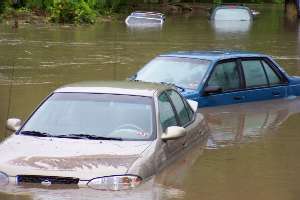|
|
 |
|
|
|
 |
| |
|
|
 |
Weather
More |
Flash floods
Floods are among the most frequent and costly natural disasters in terms of human hardship and economic loss. As much as 90 percent of the damage related to all natural disasters (excluding droughts) is caused by floods and associated debris flows.
|
|
|
|
|
 |
|
Most communities in the Earth can experience some kind of flooding.
|
|
|
 |
1. Flooding kills almost twice as many people each year as tornadoes and hurricanes combined!
source: http://www.erh.noaa.gov/
er/cae/svrwx/flood.htm
|
|
Over the 10-year period from 1988 to 1997, floods cost in the US, on average, $3.7 billion annually. The long-term (1940 to 1999) annual average of lives lost is 110 per year, mostly as a result of flash floods. For example, 101,6 mm of rain in less than 2 hours produced a 9 m high wall of water in June 14, 1990 in Shadyside, Ohio. In consequency, 26 peoples dead, and $6-8 million damages happened.
|
Flash floods occur within six hours of a rain event, or after a dam or levee failure, or following a sudden release of water held by an ice or debris jam, and flash floods can catch people unprepared. You will not always have a warning that these deadly, sudden floods are coming. So if you live in areas prone to flash floods, plan to protect your family and property. The best response to any signs of flash flooding is to move immediately and quickly to higher ground.
|
 |
 |
 |
|
2. source: http://www.dd.org/~tale/
minden-flood/page3/
|
|
|
When storms appear with intense rainfall, the rain water cuts into the water-carved gully or a normally dry creek creating a small, fast-moving river. Flash flooding can occur in less than a minute, with enough power to wash away sections of pavement, part of houses, etc. In case of urban flooding, the land is converted from fields or woodlands to roads and parking lots, it loses its ability to absorb rainfall. Urbanization increases runoff two to six times over what would occur on natural terrain. During periods of urban flooding, streets can become swift moving rivers, while basements and viaducts can become death traps as they fill with water.
|
|
Several factors contribute to flooding. Two key elements are rainfall intensity and duration. Intensity is the rate of rainfall, and duration is how long the rain lasts. Topography, soil conditions, and ground cover also play important roles. Most flash flooding is caused by slow-moving thunderstorms, thunderstorms repeatedly moving over the same area, or heavy rains from hurricanes and tropical storms. Floods, on the other hand, can be slow- or fast-rising, but generally develop over a period of hours or days.
Flash floods can roll boulders, tear out trees, destroy buildings and bridges, and scour out new channels. Rapidly rising water can reach heights of 30 feet or more. Furthermore, flash flood-producing rains can also trigger catastrophic mud slides.
The floods are very dangerous, because only 15 cm of fast-moving water could sweep a person off their feet and cars can become buoyant in about 61 cm of water.
Compiled by Sándor Szalai - Hungarian Meteorological Service
Scientific reviewing: Dr. Ildikó Dobi Wantuch / Dr. Elena Kalmár - Hungarian Meteorological Service, Budapest
Last updated: 2004-02-23
Further reading:
http://weathereye.kgan.com/cadet/flood/about.html
http://www.nws.noaa.gov/om/brochures/ffbro.htm
http://www.fema.gov/hazards/floods/flood.shtm
|
|
 |
|









